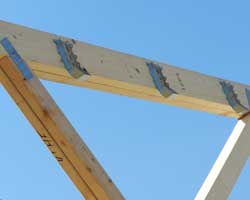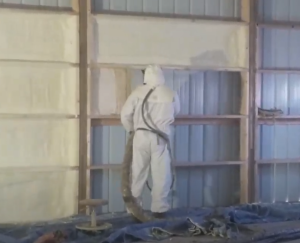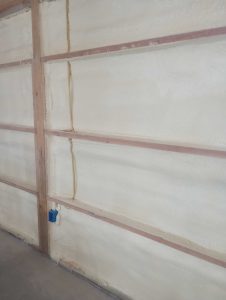This was the tag line for some PSA commercial on the telly when I was a child. Always figured I could spin it into an article at some point in time.
Here is the dilemma:
From our client:
“Got all the trusses & purlins up & it’s really starting to look like a building. That’s the good news. The bad news is I screwed up on the joist hangers.
 When I attached the joist hangers to each side of the double trusses, I dropped the bottom of the hanger down 7 5/8″ from the top of the top chord. I guess I’m used to working with 2/4’s so a 4″ side is actually 3 5/8. In looking at the manual, you say to drop 71/4 not 7 5/8. When I measure a 2×8, it comes much closer to 7 1/8 so now I have quite a gap between the bottom of the purlin & the joist hanger. My bigger worry is that since the hanger is placed lower than it should be, only four nails instead of six are attaching the hanger to the top chord of the truss. Now I’m wondering if it will meet code or be strong enough to do the job.
When I attached the joist hangers to each side of the double trusses, I dropped the bottom of the hanger down 7 5/8″ from the top of the top chord. I guess I’m used to working with 2/4’s so a 4″ side is actually 3 5/8. In looking at the manual, you say to drop 71/4 not 7 5/8. When I measure a 2×8, it comes much closer to 7 1/8 so now I have quite a gap between the bottom of the purlin & the joist hanger. My bigger worry is that since the hanger is placed lower than it should be, only four nails instead of six are attaching the hanger to the top chord of the truss. Now I’m wondering if it will meet code or be strong enough to do the job.
Nothing like hindsight. I just don’t know why I didn’t measure a 2×8 to begin with to get a more accurate measurement. Wait a minute, I know why. Because I’m always in a hurry to show some progress!
My question may have a very painful answer. Should I remove & re-position the joist hangers to move them up to the bottom of the purlins? If so, all six nails would then attach the hanger to the top chord, although I think the bottom nails would be so close to the bottom of the top chord that many would just split the bottom edge of the chord.
I don’t want to do this, but it’s totally my error & if it needs to be done I will make it right. After all it’s only 96 hangers with 8 nails in each one. I know it will take a lot of time & effort but this needs to be done so the building meets code & more importantly, is safe.
All in all though, the building is looking really great. My son, two grandsons & a neighbor helped me & we got all this done in 8 hours on Saturday.”
Lumber, it is baffling in dimensional size. The infamous 2×4 is 1-1/2” x 3-1/2” and the 2×8 1-1/2” x 7-1/4”.
So how to fix with the least amount of angst?
A solid wood shim should be placed between the seat of the hanger saddle and the bottom of the purlin. This will allow the full weight of the purlin to be carried by the hanger and not the nails.
Now the nail situation.
Live plus dead load for the purlins = 39.125 psf (pounds per square foot) X 2′ on center X 11.75’/2 (1/2 of the length of the purlin) = 459.72# of reaction at each end of the purlins
If the trusses are built from HemFir or SPF (species with lowest specific gravity meaning the weakest wood) then four nails are going to be good for 515# of roof load, if DFir/SYP, then 725#.
It is the nails, not the hanger itself which is doing the magic.
Of course there is always a little spin to add:
“Stop the research as I know what I need to do. Unfortunately, I used the incorrect nails for the hanger to truss connection. When I went to Lowes for joist hanger nails, they pointed out the 10d x1 1/2 nails. That’s what I used for all the connections. After doing research today, I found out that the 1 1/2″ nails are OK for the hanger to purlin connection but I need 10d 3″ nails for the hanger to truss connection. My load bearing is totally compromised. I will need to remove all the hangers & re-position them & use the correct nails. In doing the research, it seems that this confusion is fairly common. Wow, it looks like I will have a bunch of corrective work to do but better to discover this error now than after I was much farther along.
I guessing that after I get this fixed, I will be a little more careful before I move on to the rest of the construction.
Hope your day is better than mine.”
This is why the local lumber yard or big box retailer might not be the best source of information. The building plans and the Construction Manual do happen to show the hangers connected to the double trusses with three inch long nails. This gives a direct transfer of the applied loads to each of the members of the truss pair. As long as the trusses are adequately connected by three inch nails per the plans and/or sealed truss drawings (whichever is most restrictive) then all should be good to go.
Need advice on how to properly structurally design and assemble a post frame building – whether ours or someone else’s? It might behoove one to take a moment and Ask the Pole Barn Guru: https://www.hansenpolebuildings.com/ask-the-pole-barn-guru/
As my Daddy used to say, “The asking is for free”!









